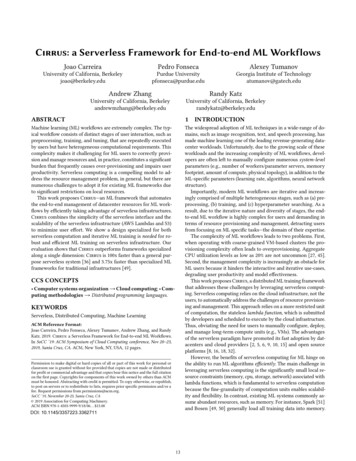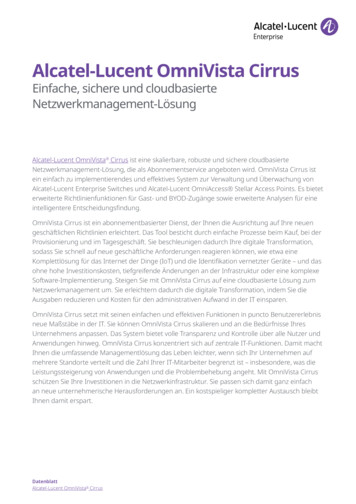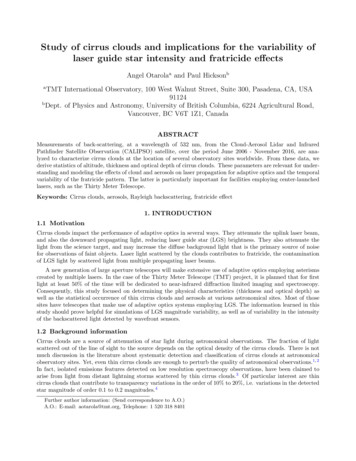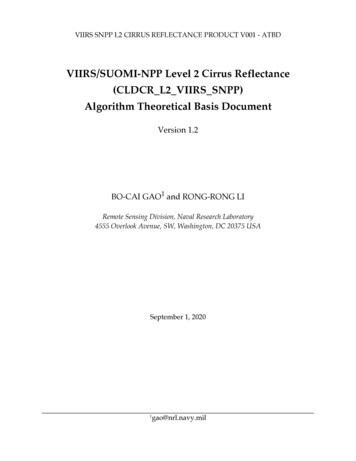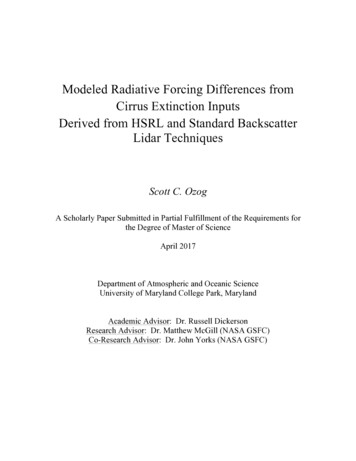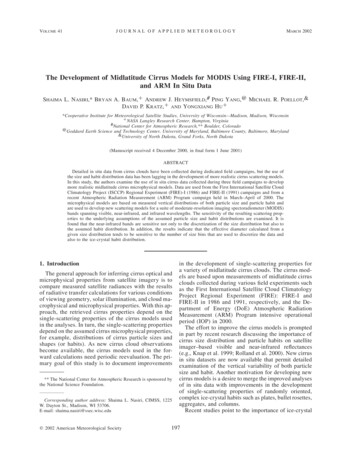
Transcription
VOLUME 41JOURNAL OF APPLIED METEOROLOGYMARCH 2002The Development of Midlatitude Cirrus Models for MODIS Using FIRE-I, FIRE-II,and ARM In Situ DataSHAIMA L. NASIRI,* BRYAN A. BAUM,1 ANDREW J. HEYMSFIELD,# PING YANG,@ MICHAEL R. POELLOT,&DAVID P. KRATZ,1 AND YONGXIANG HU1*Cooperative Institute for Meteorological Satellite Studies, University of Wisconsin—Madison, Madison, Wisconsin1NASA Langley Research Center, Hampton, Virginia#National Center for Atmospheric Research,** Boulder, Colorado@Goddard Earth Science and Technology Center, University of Maryland, Baltimore County, Baltimore, Maryland&University of North Dakota, Grand Forks, North Dakota(Manuscript received 4 December 2000, in final form 1 June 2001)ABSTRACTDetailed in situ data from cirrus clouds have been collected during dedicated field campaigns, but the use ofthe size and habit distribution data has been lagging in the development of more realistic cirrus scattering models.In this study, the authors examine the use of in situ cirrus data collected during three field campaigns to developmore realistic midlatitude cirrus microphysical models. Data are used from the First International Satellite CloudClimatology Project (ISCCP) Regional Experiment (FIRE)-I (1986) and FIRE-II (1991) campaigns and from arecent Atmospheric Radiation Measurement (ARM) Program campaign held in March–April of 2000. Themicrophysical models are based on measured vertical distributions of both particle size and particle habit andare used to develop new scattering models for a suite of moderate-resolution imaging spectoradiometer (MODIS)bands spanning visible, near-infrared, and infrared wavelengths. The sensitivity of the resulting scattering properties to the underlying assumptions of the assumed particle size and habit distributions are examined. It isfound that the near-infrared bands are sensitive not only to the discretization of the size distribution but also tothe assumed habit distribution. In addition, the results indicate that the effective diameter calculated from agiven size distribution tends to be sensitive to the number of size bins that are used to discretize the data andalso to the ice-crystal habit distribution.1. IntroductionThe general approach for inferring cirrus optical andmicrophysical properties from satellite imagery is tocompare measured satellite radiances with the resultsof radiative transfer calculations for various conditionsof viewing geometry, solar illumination, and cloud macrophysical and microphysical properties. With this approach, the retrieved cirrus properties depend on thesingle-scattering properties of the cirrus models usedin the analyses. In turn, the single-scattering propertiesdepend on the assumed cirrus microphysical properties,for example, distributions of cirrus particle sizes andshapes (or habits). As new cirrus cloud observationsbecome available, the cirrus models used in the forward calculations need periodic reevaluation. The primary goal of this study is to document improvements** The National Center for Atmospheric Research is sponsored bythe National Science Foundation.Corresponding author address: Shaima L. Nasiri, CIMSS, 1225W. Dayton St., Madison, WI 53706.E-mail: shaima.nasiri@ssec.wisc.eduq 2002 American Meteorological Societyin the development of single-scattering properties fora variety of midlatitude cirrus clouds. The cirrus models are based upon measurements of midlatitude cirrusclouds collected during various field experiments suchas the First International Satellite Cloud ClimatologyProject Regional Experiment (FIRE): FIRE-I andFIRE-II in 1986 and 1991, respectively, and the Department of Energy (DoE) Atmospheric RadiationMeasurement (ARM) Program intensive operationalperiod (IOP) in 2000.The effort to improve the cirrus models is promptedin part by recent research discussing the importance ofcirrus size distribution and particle habits on satelliteimager–based visible and near-infrared reflectances(e.g., Knap et al. 1999; Rolland et al. 2000). New cirrusin situ datasets are now available that permit detailedexamination of the vertical variability of both particlesize and habit. Another motivation for developing newcirrus models is a desire to merge the improved analysesof in situ data with improvements in the developmentof single-scattering properties of randomly oriented,complex ice-crystal habits such as plates, bullet rosettes,aggregates, and columns.Recent studies point to the importance of ice-crystal197
198JOURNAL OF APPLIED METEOROLOGYTABLE 1. Cloud-top and cloud-base temperatures for in situ datacases.DateCloud-top temperature Cloud-base temperature(8C)(8C)22 Oct25 Oct28 Oct1 Nov2 NovFIRE-I (1986)23723423724424321521522021722025 Nov26 Nov5 DecFIRE-II (1991)2552552652322222399 Mar13 MarARM (2000)250250230220habit in retrievals of ice water path, particle size, andoptical depth in cirrus clouds. The dependence of retrieved optical thickness on crystal habit has been demonstrated by Mischenko et al. (1996), Doutriaux-Boucher et al. (2000), and others. One of the most completein situ radiation measurement studies was by Francis etal. (1999). They discussed aircraft measurements ofmidlatitude cirrus collected by the Met Office C-130aircraft during a flight on 9 November 1995 off the eastcoast of Scotland. In situ microphysical data were obtained within a thin layer of frontal cirrus, together withdownwelling filter-band radiometer measurements at0.87, 1.61, 3.7, 8.55, and 11 mm. Banked orbits wereflown below the cirrus to sample at scattering anglesranging from 218 to 1278 relative to the sun. To inferoptical thickness and particle size, radiative transfer calculations were presented for monodistributions of fiveindividual crystal habits: randomized polycrystals(Macke et al. 1996), hexagonal columns, hexagonalplates, six-branched bullet rosettes, and aggregates composed of hexagonal columns. For a cirrus cloud composed of a single habit, single-scattering properties wereobtained by integrating over size distributions using effective radii (defined as the ratio of total volume to totalprojected area) ranging from 9.4 to 85.9 mm. A raytracing technique was employed to derive single-scattering properties of the ice crystals. Francis et al. (1999)found that the cirrus composed of polycrystals producedeffective sizes that were consistent with the in situ dataacross all the wavelengths considered. However, the retrieved 0.87-mm optical thicknesses were considerablyless than those derived at 11 mm, implying a problemwith the phase function at solar wavelengths for thepolycrystal over a wide range of primarily side-scattering angles. Francis et al. (1999) explain that the errorin effective size retrieval introduced by the polycrystaloverprediction of side scattering is canceled by its underprediction of single-scattering albedo. Francis et al.also note the importance of characterizing realistic cirrusVOLUME 41TABLE 2. Spectral and radiometric characteristics of the Earth Observing System Terra platform MODIS spectral bands used in thisstudy.Band No.Centralwavelength(mm)Principal absorbing 2H2O, O2, O 3H 2O, CO 2, CH 4H 2O, CO 2, CH 4, N 2OH 2O, CO 2, CH 4H 2OH 2O, O 3, CH 4, N 2OH 2O, CO 2H 2O, CO 2ice particles and show that their retrieved optical thicknesses compared better to theory when a laboratoryderived phase function reported by Volkovitskiy et al.(1980) was employed.Baran et al. (1999) used the dual-view geometry ofalongtrack scanning radiometer (ATSR)-2 data to estimate the most likely dominating crystal shape at 0.87mm. In their study, radiative transfer (RT) calculationswere performed for cirrus composed of a single crystaltype: hexagonal plates, hexagonal columns, sixbranched bullet rosettes, or randomized polycrystals.The simulated radiances subsequently were comparedto selected ATSR-2 data from a tropical convective cirrus case and a midlatitude cirrus case. For the tropicalcase, the best comparison between the ATSR-2 data at0.87 mm and RT calculations was obtained for the randomized polycrystal, perhaps due to the lack of enhanced intensity features in the phase function at backscattering angles. For the midlatitude cirrus case, comparison was made between extinction optical depth retrievals using ATSR-2-measured radiances, aircraftmeasurements of midlatitude cirrus at 0.87 and 11 mm,and in situ–calculated optical thickness (Francis et al.1999). It is interesting that the best comparison wasobtained using a phase function obtained from laboratory measurements (Volkovitskiy et al. 1980) rather thanfrom the randomized polycrystal. Baran et al. (1999)suggested that the aircraft samples the phase functionat mostly side-scattering angles rather than backscattering angles, suggesting that perhaps the polycrystal isless optimal at side-scattering angles.Given the importance of cirrus microphysics in remote sensing applications, we now turn attention tothe current set of operational moderate-resolution imaging spectroradiometer (MODIS) cirrus models(Baum et al. 2000). The microphysical data are derivedfrom the following sources. The cirrostratus and cirrusuncinus distributions are described by Heymsfield(1975), and Heymsfield and Platt (1984) present twomodified size distributions typical of warm and coldcirrus clouds and three additional cirrus distributionsthat represent midlatitude cirrus at temperatures T 52208, 2408, and 2608C. The seven size distributions
MARCH 2002NASIRI ET AL.TABLE 3. Particle number distributions based on five size bins.MaxBindimension width(mm) (mm)15451302757502040100260640Number concentration (L21 10 163.53733333310 010 0102110221023cover a range of cloud microphysical properties anddynamical regimes, for example, production in slowlyascending parcels to 100 cm s 21 updrafts. Most of thecirrus were sampled aboard a Cessna Citation jet usingthree different probes (Heymsfield 1975; Heymsfieldand Platt 1984): 1) a forward-scattering spectrometerprobe (FSSP) for particle sizes ranging between 2 and30 mm in 2-mm intervals; 2) a one-dimensional opticalarray probe (1D-C) to obtain particle sizes between 20and 300 mm in 20-mm intervals, and 3) a one-dimensional precipitation probe (1D-P) to size particles between 200 and 3000 mm in 200-mm intervals. A Formvar (polyvinyl formal—a plastic) replicator was employed to provide data on particle habits for crystalsless than 200 mm in size; larger particles tended tobreak up upon impact.Given the limitations of the 1D-C and 1D-P measurements, the size spectra for the MODIS cirrus modelsin Baum et al. (2000) are limited to five discrete sizeregions. When the maximum dimension D is small (D, 70 mm), that is, for small ice crystals, the percentageof ice crystals within the size region is assumed to becomposed of 50% bullet rosettes, 25% hexagonal plates,and 25% hollow hexagonal columns. When D is greaterthan 70 mm, the percentage of ice crystals within the199size region is assumed to be composed of 30% aggregates, 30% bullet rosettes, 20% hexagonal plates, and20% hollow hexagonal columns. The mixture of habitsin this initial set of cirrus models is a function only ofparticle size and is invariant between models.Recent improvements in the instrumentation used toobtain in situ cirrus measurements provide, for the firsttime, a basis for discussing vertical variability of sizeand habit distributions. The cirrus measurements fromFIRE-II are from a balloonborne ice-crystal replicator(Heymsfield and Miloshevich 1995), which provideshigh-quality image, size, and concentration information for particles 10 mm and above. With this replicator,ice crystals have less of a tendency to break up uponcollection because of the slow rise rates (4–5 m s 21 )of the balloon (Miloshevich and Heymsfield 1997). Thecirrus measurements from FIRE-I (Heymsfield et al.1990; Sassen et al. 1994) and ARM are based on twodimensional crystal cloud (2D-C) and precipitation(2D-P) probe data. The 2D-C probe sized particlesfrom 25 to about 1000 mm in 25-mm increments, andthe 2D-P probe sized particles from 100 to above 2000mm in 100-mm increments. The 2D-C and, especially,the 2D-P are insufficient to obtain much informationon habits, especially for the smaller crystals. For FIREI, habit information was provided through collectionof particles directly on oil-coated slides (Sassen et al.1994). For the ARM campaign, cirrus-particle habitdata were provided through use of the SPEC, Inc.,cloud particle imager (CPI), which provides detailedimagery of particles, beginning at about 40 mm with2.3-mm resolution.With recent advances in developing single-scatteringproperties for ice crystals and the improvements in insitu data from cirrus clouds, it is now possible to developFIG. 1. Size distributions based on five size bins for the (a) FIRE-I, (b) FIRE-II, and (c) ARM cirrus microphysical models described insection 3.
200JOURNAL OF APPLIED METEOROLOGYVOLUME 41FIG. 2. Size distributions based on 27 size bins for the (a) FIRE-I, (b) FIRE-II, and (c) ARM cirrus microphysical models described insection 3.more complex cirrus scattering models that includemore realistic particle size and habit distributions. Inthis study our intent is to form a new set of cirrus modelsbased upon the particle size distribution and habit distribution observed by in situ measurements of cirrus.Previous studies involving in situ cirrus measurementshave tended to focus on variability in the horizontal,whereas we wish to emphasize the vertical variability.The new cirrus models represent a significant improvement in the treatment of both the size distribution andthe percentages of particle habits. The new cirrus modelsare based on 27 size bins, whereas the initial set ofmodels was based on five size bins. The percentage ofcrystal habits for each size bin is based on reanalysesof in situ measurements from visual examination of slidecollections (FIRE-I), balloonborne replicator data(FIRE-II), or CPI data (ARM).Section 2 presents the data and models used in ouranalyses. Section 3 outlines the development of the newcirrus models. Results of RT calculations of top-of-atmosphere reflectances and brightness temperature differences are presented in section 4. Section 5 summarizes and concludes our study.2. Data and modelsa. Balloonborne replicator data: FIRE-IIdistributionsThe FIRE-II size distributions were measured on 25and 26 November and 5 December 1991 by the NationalCenter for Atmospheric Research (NCAR) balloonborneFormvar replicator (Miloshevich and Heymsfield 1997).Cloud characteristics for each of the FIRE-II cases arelisted in Table 1. The size distribution data are discretized into 27 size regions ranging from 10 mm to thelargest measured size of 540 mm at approximately 100m vertical layers through the cloud, with a visual classification of the two dominant crystal habits at eachlevel. Images of vertical crystal profiles apparently showthe presence of three vertical layers (Heymsfield andMiloshevich 1995): a production layer composed mostlyof pristine crystals such as columns or plates, a growthlayer, and a sublimation layer composed of large andoften aggregated crystals.An average number of particles per size bin is determined by integration over the height of each cloudlayer as follows:Ocloud basen(D) 5n(D, l)Dz(l)l5cloud topcloud baseO,(1)Dz(l)l5cloud topwhere l is a layer, D z( l ) is the thickness of layer l,and D is the center maximum dimension of the sizebin. To determine the layer-averaged percentage ofhabit h at size D, the habit information is averagedover height:Ocloud basef (h, D) 5f (h, D, l)n(D, l)Dz(l)l5cloud topcloud baseO,(2)n(D, l)Dz(l)l5cloud topwhere f (h, D, l) is the percentage of habit h at size Dand layer l.b. Aircraft data1) FIRE-I DISTRIBUTIONSThe FIRE-I data were collected from the NCAR KingAir turboprop in October and November of 1986 over
MARCH 2002201NASIRI ET AL.FIG. 3. As in Fig. 2, but the maximum crystal size is limited to 1200 mm so that more detail is presented for the small-crystal size range.Wisconsin. Ice particle size spectra were derived fromParticle Measuring Systems, Inc., 2D-C and 2D-P imaging probe data. The 2D-C and 2D-P probes on theKing Air measured particle size in 25- and 100-mmintervals, respectively. A careful examination of slidecollections provided information on the ice-particle habit percentages and the presence of small particles. Ingeneral, few small particles were noted in the collections. The data from the FSSP probe (2–30 mm) wereexamined to see whether there were any pockets of liquid water or whether anomalously high concentrations(more than a few tenths per cubic centimeter) were present, which might suggest the presence of relatively highconcentrations of ice particles. No such high concentrations were detected, suggesting that relatively lowconcentrations of total (and sub-2D-C size) particleswere present. We have not attempted to account for thepotential underrepresentation of small particles in the2D-C data.Cirrus cloud measurements on 22, 25, and 28 October,and 1–2 November of 1986 are used in this study. Theaircraft climbed to cloud top in each case and then conducted a slow, Lagrangian-type spiral descent downward to cloud base. All FIRE-I data used were collectedduring the Lagrangian spiral descents. Cloud characteristics for each of the FIRE-I cases are listed in Table1. The merged number concentration datasets use the2D-C probe data for particle sizes between 25 and 600mm and the 2D-P probe for 600–4000 mm. The numberconcentrations and habit distributions throughout thecloud are merged to create an averaged single-layercloud model size distribution byOcloud basen(D) 5n(D, j)j5cloud top(3)Nobsand habit distributionOcloud basef (h, D) 5f (h, D, j)j5cloud topNobs,(4)respectively, where Nobs is the number of observationsand j represents a single flight track through the cloudlayer.2) ARM IOPDISTRIBUTIONSThe ARM data were collected on 9 and 13 March2000 by the University of North Dakota Citation aircraftnear the ARM Cloud and Radiation Test Bed site inOklahoma. Cloud characteristics are listed in Table 1.The data from 9 March are of a Lagrangian spiral, andthose of 13 March are for the entire flight. Ice-particlesize spectra were derived from 2D-C and 2D-P probedata. The merged number concentration dataset uses theTABLE 4. Average maximum dimension and effective diameter based on the microphysical models described in section 3.5 size-bin fixed habit distribution27 size-bin fixed habit distribution27 size-bin measured habit distributionField campaign D& (mm)D e (mm) D& (mm)D e (mm) D& (mm)D e 63.3101.2124.255.984.679.363.3101.2138.256.561.0
202JOURNAL OF APPLIED METEOROLOGYTABLE 5. Particle number distributions for 27 size bins.MaxBindimension width(mm) 87.5650.0 100.0750.0 100.0850.0 100.0950.0 150.01150.0 225.01400.0 300.01750.0 550.02500.0 875.03500.0 1000.0TABLE 6. Fixed and measured habit distributions. All particle sizesD are in micrometers.Number concentration (L21 mm21 83.43275.35462.266133333333333333333333333333310 010 010 0102110 010 000033333333333333333333333333310 010 0102110 024102410 010 010 010 010 010 010 010 010 333333333VOLUME 4110 010 010 010 01021102110 010 0231024102410251025102610282D-C probe data for particle sizes between 25 and 900mm and the 2D-P probe data for 900–4000 mm. Wehave not accounted for the potential underrepresentationof small crystals in the 2D-C data. Averaged singlelayer cloud model size distributions are determined fromEq. (4). Particle habit distributions were derived fromvisual examination of SPEC, Inc., CPI data. Virtuallyall of the particles were bullet rosettes with an averageof five bullets per rosette. Larger particles were aggregates of rosettes.c. Single-scattering propertiesAn extensive library of single-scattering propertieshas been prepared that encompasses five randomly oriented crystal habits, 27 size bins, and 10 subbands within each of the MODIS band numbers in Table 2. Thecrystal habits are solid hexagonal columns, hexagonalplates, hollow hexagonal columns, two-dimensionalbullet rosettes, and moderately rough aggregated columns. Because the columnar crystals in the King Airslide collections and in the replicator data are hollow,all columnar crystals are treated as being hollow columns. The size bins span a maximum dimension rangeof 3–3500 mm.The single-scattering calculations are derived using acombination of the improved geometric optics method(GOM2) and the finite-difference time domain (FDTD)techniques discussed in Yang and Liou (1996a,b). TheFirst size limitD , 70mmBullet rosettesHexagonal platesHollow columnsAggregates50%25%25%0%Second size limitD . 70mmBullet rosettesHexagonal platesHollow columnsAggregates30%20%20%30%FIRE-IFIRE-IID , 150 D , 100mmmm37%0%63%0%35%46%17%3%D . 150 D . 100mmmm33%0%27%40%38%0%22%40%0%75%6%19%100 mm ,D , 800mm100%0%0%0%D . 800mmThird size limitBullet rosettesHexagonal platesHollow columnsAggregatesARMD , 100mm0%0%0%0%0%0%0%0%0%0%0%0%75%0%0%25%FDTD is applied to particles having a size parametersmaller than 20, whereas GOM2 is employed for sizeparameters larger than 20. Calculated properties includethe extinction coefficient, single-scattering albedo, fraction of delta-transmitted energy, asymmetry parameter,and scattering phase function.d. Atmospheric absorptionFor this study, we have focused our attention uponthe creation of correlated k-distribution routines for thespectral regions corresponding to the MODIS channels.Because these correlated k-distribution routines havebeen formulated specifically for the MODIS channelsrather than being adapted from other studies, we can beassured that the routines correctly represent the observed radiative impact due to molecular absorptionwithin these spectral bands. Although our correlated kdistribution routines could be applied to an assessmentof the state of the molecular inventory within the atmosphere, we have used these routines to remove themolecular signal from the data, thereby allowing for ananalysis of the radiative impacts of other aerosols,clouds, surface conditions, and so on.A major advantage of using the correlated k-distribution method is that it can be incorporated directlyinto multiple scattering routines used to consider scattering as well as absorption by clouds and aerosol particles (Lacis and Oinas 1991). Kratz (1995) providesan in-depth description of the method used to createthe correlated k-distribution routines. For both thatstudy and our investigation, the derivation of the correlated k distributions has been based upon an exponential sum fitting of transmissions technique (Wis-
MARCH 2002203NASIRI ET AL.TABLE 7. Single-scattering albedos v o for a set of MODIS wavelengths derived for the cirrus microphysical models described insection 3.FIRE-I5 size-binsl (mm) fixed 90630.85550.65130.58030.53970.5680FIRE-II27 size-bins27 size-bins measuredfixed 56485 size-binsfixed habitARM27 size-bins27 size-bins measuredfixed 00.5653combe and Evans 1977) that was applied to the resultsof line-by-line calculations that were run at predetermined reference pressure and temperature conditions.Both studies have relied upon the multiplication transmissivity property to account for the overlap of thespectral features associated with the various molecularspecies. We have established the accuracy of the correlated k distribution technique, as compared with theline-by-line method, by running atmospheric flux andheating rate calculations for a wide variety of atmospheric .56415 size-binsfixed habit27 size-binsfixed habit27 10.53560.5694for all of the models but the number concentration ofice crystals per size bin varies between the models. Thedata upon which we base this study were collected during the FIRE-I (1986), FIRE-II (1991), and ARM IOP(2000) field campaigns. As discussed in section 2, thedata are culled from five cirrus flight missions duringFIRE-I, three flight missions during FIRE-II, and twoflight missions during the ARM IOP.Two values used to describe a given particle size distribution are the average maximum dimension and theeffective diameter. The average maximum dimension ofa distribution D& is defined asO Dn(D)D(D),O n(D)D(D)e. Radiative transfer modelBaum et al. (2000) describe the use of a discreteordinates radiative transfer model to calculate the topof-atmosphere (TOA) radiances expected for a range ofclear and cloudy conditions for the wavelengths listedin Table 2. The atmosphere is composed of a discretenumber of adjacent homogeneous layers. Within eachlayer, the single-scattering albedo and optical thicknessare constant, but these values may vary from layer tolayer. For the 1.64-, 1.38-, 2.13-, 3.78-, 8.5-, 11-, and12-mm channels, the atmosphere is divided into 34 layers between the surface and 70 km. For each layer, thecorrelated k-distribution routines discussed in the previous section are implemented to calculate optical thicknesses due to gaseous absorption. For the 0.65-mm channel, for which ozone is the principal absorber and Rayleigh scattering is important, the atmosphere is modeledwith four layers. The first (uppermost) layer includesthe effect of ozone absorption and Rayleigh scatteringfrom the tropopause to the TOA. The second layer includes Rayleigh scattering between the top of the uppermost cloud and the tropopause. The third layer contains the optical properties for either a water or an icephase cloud. The layer below the cloud contains Rayleigh scatterers. Aerosol contributions are neglected inthis study.where Dmin and Dmax describe the minimum and maximum crystal sizes in the distribution, respectively, andD(D ) is the width of size bin D. The average maximumdimension characterizes the bulk properties of the sizedistribution. The second value is the effective diameterD e . Wyser and Yang (1998) demonstrated that the details of the size distribution are relatively unimportantin specifying the bulk optical properties of cirrus whenthe effective size is calculated as the total volume Vof the particles divided by the total projected area A.This definition is related directly to ice water contentIWC because V 5 IWC/r, where r is the density ofice. We define D e after Foot (1988) and Francis et al.(1994) as3. Development of cirrus modelsa. Cirrus microphysical modelsIn the MODIS version-1 cirrus models described byBaum et al. (2000), the habit distribution is the samewhere f (h, D) is the percentage of a specific particlehabit for size D, and n(D) is the number concentrationof crystals.To investigate the effects of habit distribution andnumber of size bins on the cirrus single-scattering prop-Dmax D& 5D5DminDmax(5)D5DminO [O V(h, D) f (h, D)n(D)D(D)],O [O A(h, D) f (h, D)n(D)D(D)]DmaxDe 543 D5Dmin2 Dmaxh51D5Dminh51(6)4
204JOURNAL OF APPLIED METEOROLOGYVOLUME 41FIG. 4. Scattering phase functions based on FIRE-I data for the three cirrus microphysical models described in section 3 for fourwavelengths: 0.65, 1.64, 3.78, and 11.0 mm.erties (SSP), we created three sets of cirrus models usingthe SSP library. The three model sets are as follows.1) The cirrus models, based on FIRE and ARM in situmeasurements, have five size bins and the MODISversion-1 fixed habit percentages (i.e., the same habitpercentages are used for each model). The maximumdimension does not exceed 1100 mm.2) The cirrus models have expanded size distributions(27 size bins) based on in situ data but have theMODIS version-1 fixed habit distribution.3) The cirrus models have expanded size distributionscontaining 27 size bins and habit distributions basedon in situ data.These models will now be discussed in detail.1) CIRRUSMODELS: FIVE SIZE BINS AND FIXEDHABIT DISTRIBUTIONAs a first step in developing cirrus models from insitu data, the first set of models is patterned after thosepresented in Baum et al. (2000). The flight-track-av-eraged size distributions are discretized into five sizebins as shown in Fig. 1 and tabulated in Table 3. Aswith the Baum et al. (2000) models, however, the habitdistributions for each bin are kept constant for eachmodel. When the maximum dimension D is small (D, 70 m m), that is, for the smallest two size bins, thepercentage of ice crystals within the size region isassumed to be 50% bullet rosettes, 25% hexagonalplates, and 25% hollow hexagonal columns. When Dis greater than 70 mm (i.e., for the largest three sizebins), the percentage of ice crystals
VOLUME 41 JOURNAL OF APPLIED METEOROLOGY MARCH 2002 q 2002 American Meteorological Society 197 The Development of Midlatitude Cirrus Models for MODIS Using FIRE-I, FIRE-II, and ARM In Situ Data SHAIMA L. NASIRI,* BRYAN A. BAUM,1 ANDREW J. HEYMSFIELD,# PING YANG,@ MICHAEL R. POELLOT,& DAVID P. K RATZ,1 AND YONGXIANG HU1 *Cooperative Institute for Meteorological Satellite Studies, University of .



